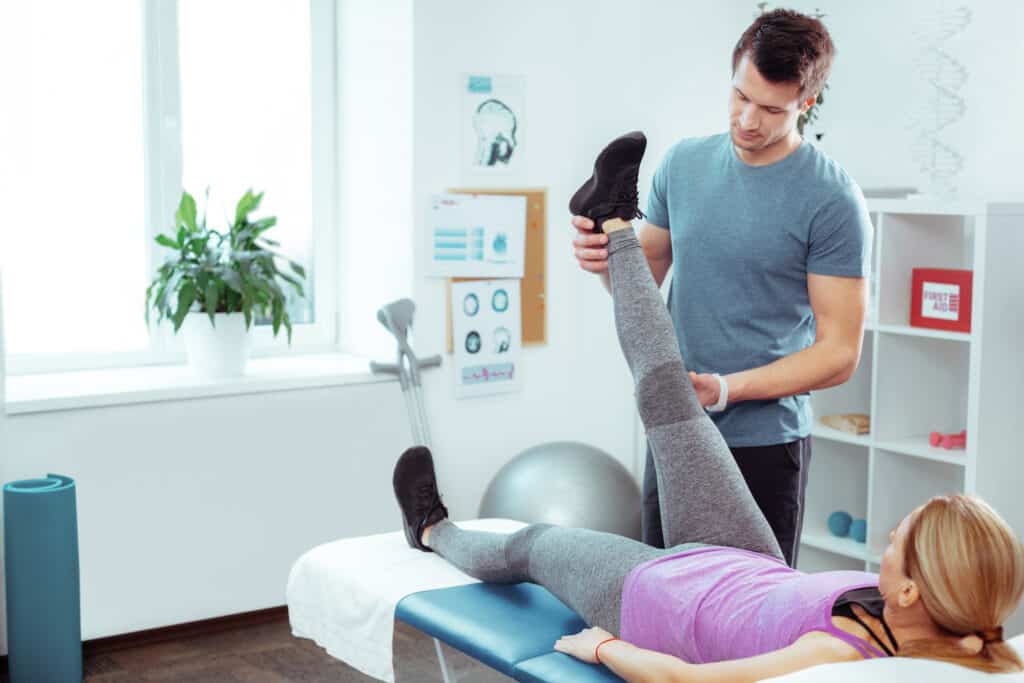
If you’ve ever had a running injury, you know how hard it can be to find the motivation and determination to keep up with your fitness routine.
Or you have all this energy and want to get moving, but you’re not sure whether it’s safe to resume running. Don’t worry. We’re here to put your mind at ease.
There are various ways you can still enjoy your favorite activity safely while also promoting healing.
In addition, we have some great tips on how to run safely with an injury so that everyone who has suffered a setback – whether you’re a beginner, seasoned runner, or professional athlete – can get back on track quickly.
So, before you lace up those running shoes or hit the gym, read our guide to running safely.
More Blogs From RPM Physical Therapy:
The Physical Therapist’s Guide To Running Safely

Okay, folks, let’s get down to it. Starting with the importance of warming up. You might think it’s unnecessary and just run right out the door and start jogging.
But you can reduce your risk of injury and prevent exacerbating any existing injuries by taking a few minutes to do some dynamic stretches and mobility drills first.
Not only does this extra step prevent running injuries, but it can also improve your performance by warming up your muscles and getting them ready to go.
So next time you’re about to hit the sidewalk or your favorite running trail, take a few extra minutes to warm up your body properly.
Running is an excellent exercise, but it can be tough on your feet. Therefore, wearing proper running shoes is crucial to prevent potential injuries.
They are specifically designed to provide support, stability, and cushioning to absorb the shock of each step and protect your feet, ankles, knees, and lower back.
They also help improve your running form, increase speed and endurance, and reduce fatigue and muscle soreness.
Investing in a good pair of running shoes that fit well and suit your individual needs can save you a lot of trouble in the long run and help you reap all the benefits of running without any downsides.
Next, talk about adjusting your running technique and how that can help.
Simply put, if you’re experiencing pain, you can tweak your running form to minimize it. Of course, pain happens, especially if you have old injuries that flare up occasionally.
But, whether it’s a sore knee or a tight hip flexor, the last thing you want is for it to impede your speed or running progress.
That’s where tweaking your running form can come in handy. It’s a simple solution that can minimize the discomfort you’re feeling.
All you need is a bit of awareness and some minor adjustments to your form that a physical therapist can teach you.
But you need professional advice first, don’t just run through the pain and hope for the best when you don’t know the issue because this can cause permanent damage.
But the most fundamental thing you must do to ensure that you run safely is listen to your body.
It’s so easy you keep pushing – but you must pay attention to any obvious signs of pain or discomfort and take a break if needed.
Take a step back and listen to what your body tells you – it’ll save you a lot of pain and frustration in the long run.
Start slowly and gradually increase the intensity as you become more comfortable running again. This takes us nicely on to “pacing.”
Sure, jumping right back in after an injury and pushing to the max can be tempting, but trust me, starting slow and gradually increasing intensity is the way to go.
Not only does it help prevent injury, but it also allows you to get comfortable running again after any time away. So, start with a light jog, and pick up the pace as you go if you don’t feel pain.
Finally, make sure you cool down after running with light stretches and adequate rest days between your runs.
Cooling down is often overlooked, but it’s crucial for avoiding injuries and improving your running performance over time.
Your body needs time to recover properly after pushing yourself to the running limit. So, again, take some time to do some light stretches at the end of your run and the start. Your body will return stronger after a good cool down and adequate rest.
Running is a fun and rewarding exercise that can help you stay fit and healthy. Still, taking precautions when you return after an injury or long break is important.
All these tips can help you safely return to running after an injury so you can focus on your running goals again. So, whether you want to complete a 5K or a marathon or just want to stay healthy, keep these ideas in mind.
What Are The Most Common Running Injuries?

The unfortunate thing about running is that runners are prone to picking up injuries because it can be quite a high-impact sport.
However, when you understand the basics of running injuries and why they occur, you can take steps to prevent them and stay injury-free.
Knowing the difference between an acute injury and a chronic overuse injury is important, too, along with proper form, appropriate footwear, and how to warm up and cool down before and after your runs.
Running is a great way to stay in shape, build endurance and improve cardiovascular health. But, unfortunately, it can also strain the body, leading to running injuries that can significantly affect your training schedule and quality of life.
Knowing what type of injury you are suffering from and how to combat it can help you reduce the chances of further damage so that you can continue running safely and effectively for many years.
The most common running injuries include:
This painful condition occurs when the muscles and tendons in your shin become overworked and inflamed.
A few common causes of shin splints include high-impact activities like running or jumping, overuse without proper rest, and wearing unsupportive shoes. Fortunately, there are several steps you can take to avoid this common problem.
Be sure to stretch properly before and after your workout, start with a low-impact warm-up, and invest in high-quality, supportive footwear to protect your feet and legs as you tackle your fitness goals.

Runner’s knee, hip pain, and IT band syndrome:
As a runner, you want to keep your body healthy and injury-free to continue running. The three most common issues runners face are knee and hip pain and IT band syndrome.
Fortunately, there are several things you can do to prevent these issues from occurring. These preventative measures include warming up properly before a run, incorporating strength training to support your joints and muscles, adjusting your running form, and allowing for proper rest and recovery time.
Stress fractures:
A stress fracture is an injury that can occur in runners from overuse or repetitive stress on the bones.
It is a small crack or breaks in a bone that can result from the constant impact of running. Stress fractures are commonly seen in the feet and legs of runners, particularly in the shinbone (tibia) and foot bones.
Symptoms of a stress fracture may include pain, swelling, tenderness, and difficulty bearing weight on the affected leg. If you suspect you have a stress fracture, it’s important to seek medical attention immediately to prevent further injury.
Achilles tendinitis is a condition that occurs when the Achilles tendon, which connects the calf muscles to the heel bone, becomes inflamed or irritated.
It is often caused by overuse or repetitive stress on the tendon. It is common among runners and other athletes who engage in activities that involve frequent jumping or sudden starts and stop.
Symptoms of Achilles tendinitis may include pain, stiffness, swelling, and tenderness in the back of the heel or calf.
Treatment typically involves rest, ice, compression, elevation, and physical therapy exercises to help stretch and strengthen the affected tendon. In severe cases, surgery may be necessary.
However, these injuries are not inevitable, and with proper preventative measures, they can be avoided.
Stretching before and after running, gradually increasing mileage, wearing appropriate shoes, and cross-training to strengthen supporting muscles are all excellent ways to prevent injuries from occurring.
In addition, taking care of your body through proper rest and nutrition is also essential in keeping your running routine injury-free.
How Physical Therapy Can Treat And Prevent Running Injuries

The impact of running injuries can be devastating. They can halt your training and force long rest periods. But that’s where physical therapy comes in.
If you’re a committed runner who wants to run faster and longer, reduce recurrent injuries, and speed up recovery, physical therapy can be incredibly effective and help to keep your body in prime physical condition – ready to tackle any run.
We can guide you and evaluate your individual needs when it comes to running and create a personalized treatment plan that we tailor to help prevent or rehabilitate your specific type of running injury.
Whether you’re just starting as a beginner runner or have been hitting the sidewalks for decades, physical therapy can help optimize your health so that running remains fun and injury-free. It’s a powerful tool for optimizing every step of your running journey.
Dr. Jonathan Ruzicka is a Manual Therapist whose experience as a private therapist for professional athletes drove him to further his education attaining unparalleled skills in tissue mobility work, performance based rehab, injury prevention, myofacial release and joint mobilization to optimize human performance.
- Physical Therapy for Oak Ridge North Residents Near The Woodlands - November 7, 2025
- 5 Lower Back Pain Stretches to Ease Your Discomfort - August 23, 2024
- How to Avoid Foot and Ankle Pain and Stay Active! - July 26, 2024


